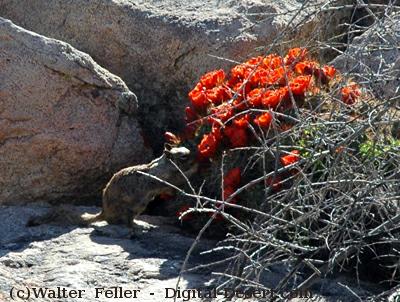Rock Squirrel
Spermophilus variegatusFamily: SCIURIDAE Order: RODENTIA Class: MAMMALIA
DISTRIBUTION, ABUNDANCE, AND SEASONALITY
Although widely distributed in the southwestern U.S. and Mexico, in California, the rock squirrel has a restricted distribution. Prefers rocky outcrops in pinyon-juniper and Joshua tree habitats, and is occasionally observed in desert scrub habitat (Hall 1946, Johnson et al. 1948, Ingles 1965, Oaks et al. 1987). Found at approximate elevations of 1200-2300 m (3940-7550 ft).
SPECIFIC HABITAT REQUIREMENTS
Feeding: Eats a variety of seeds and fruits, including juniper, cactus, mesquite, agave, currants, grasses, and pine nuts. Also eats bird eggs and young. Forages on the ground and in trees and shrubs (Olin 1975, Whitaker 1980).
Cover: Uses burrows and dens among rocks and areas beneath bushes and trees for shelter. In absence of natural rock formations, individuals may utilize human made structures such as old buildings, bridges, terraced roads, and stone walls (Oaks et al. 1987). Lines burrows with dried grass, leaves, bark and seed pods (Oaks et al. 1987).
Reproduction: Dens in a burrow under or among rocks. May use hollow trees. Copulation probably occurs within the burrow (Oaks et al 1987).
Water: Probably does not require drinking water, but drinks if water is available (Olin 1975). May go long periods of time consuming dry food alone, up to 100 days in some cases (Oaks et al. 1987).
Pattern: Prefers rocky outcrops, talus, canyons, arroyos and cliffs in pinyon-juniper and Joshua tree woodlands. Outcrops near grassy areas are preferred for feeding.
SPECIES LIFE HISTORY
Activity Patterns: Active yearlong in the southern portion of its range; hibernates in Utah and Colorado, emerging during warm spells. Probably undergoes some seasonal dormancy in California. Diurnal with activity peaks varying by season (Oaks et al. 1987). During fall, winter and spring, peak activity occurs midday; throughout summer, peak activity may occur in the morning, late afternoon, or both (Oaks et al. 1987). Extreme temperatures and strong winds result in decreased activity (Oaks et al. 1987).
Seasonal Movements/Migration: None.
Home Range: Home ranges are large, overlap and vary depending on season and breeding condition of the squirrels (Oaks et al. 1987). Johnson (1981) found female home ranges averaged 0.15 ha (0.4 ac). Lactating females had smaller home ranges averaging 0.01 ha (0.025 ac). Several females had home ranges within that of a single male, which had a home range of 0.4 ha (1 ac).
Territory: Males aggressively defend their home range, which includes those of several females. Females with litters may behave territorially to other females (Johnson 1981).
Reproduction: Data concerning length of gestation not available. Young are born from April through May. Lactation lasts approximately two months (Oaks et al.1987). Average litter sizes of 3.8 (Johnson 1981), 5-7 (Whitaker 1980), and 5-10 (Olin 1975) have been reported. Two litters per year may be produced.
Niche: Predators include bobcats (Jones and Smith 1979), hawks, snakes, and weasels (Olin 1975), ringtails, gray foxes, raccoons and coyotes (Oaks et al. 1987). This species is most similar to the California ground squirrel in ecology and social structure. In the southern Rockies the rock squirrel is a vector for plague (Tomich 1982).
REFERENCES
Hall, E. R. 1946. Mammals of Nevada. Univ. California Press, Berkeley. 710pp. Ingles, L. G. 1965. Mammals of the Pacific states. Stanford Univ. Press, Stanford, CA. 506pp. Johnson, K. 1981. Social organization in a colony of rock squirrels (Spermophilus variegatus). Southwest. Nat. 26:237-242. Johnson, D. H., M. D. Bryant, and A. H. Miller. 1948. Vertebrate animals of the Providence Mountains area of California. Univ. Calif. Zool. 48:221-375. Jones, J. H., and N. S. Smith. 1979. Bobcat (Lynx rufus) density and prey selection in central Arizona, USA. J. Wildl. Manage. 43:666-672. Oaks, E. C., P. J. Young, G. L. Kirkland, Jr., and D. F. Schmidt. 1987. Spermophilus variegatus. Mammalian Species 272:1-8. American Society of Mammalogists. Olin, G. 1975. Mammals of the southwest deserts. Southwest Parks and Monuments Assoc. Popular Ser. No. 8. 102pp. Tomich, P. Q. 1982. Ground squirrels. Pages 192-208 in J. A. Chapman and G. A. Feldhamer, eds. Wild mammals of North America. Johns Hopkins Univ. Press. Whitaker, J. O., Jr. 1980. The Audubon Society field guide to North American mammals. A. Knopf, New York. 745pp. M071 Life history accounts for species in the California Wildlife Habitat Relationships (CWHR) System were originally published in: Zeiner, D.C., W.F.Laudenslayer, Jr., K.E. Mayer, and M. White, eds. 1988-1990. California's Wildlife. Vol. I-III. California Depart. of Fish and Game, Sacramento, California. Updates are noted in accounts that have been added or edited since original publication.
Written by: V. Johnson, J. Harris Reviewed by: H. Shellhammer Edited by: S. Granholm Updated by: CWHR Program Staff, May 2000 and January 2008

Rock squirrel feeding on mound cactus on rocky outcrop near grassy area.